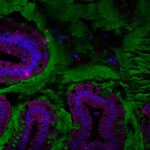Link to Pubmed [PMID] – 25666140
Link to DOI – 10.1128/JB.02499-14
J Bacteriol 2015 Apr; 197(8): 1451-65
Ileal lesions of patients with Crohn’s disease are colonized by adherent-invasive Escherichia coli (AIEC), which is able to adhere to and to invade intestinal epithelial cells (IEC), to replicate within macrophages, and to form biofilms on the surface of the intestinal mucosa. Previous analyses indicated the involvement of the σ(E) pathway in AIEC-IEC interaction, as well as in biofilm formation, with σ(E) pathway inhibition leading to an impaired ability of AIEC to colonize the intestinal mucosa and to form biofilms. The aim of this study was to characterize the σ(E) regulon of AIEC strain LF82 in order to identify members involved in AIEC phenotypes. Using comparative in silico analysis of the σ(E) regulon, we identified the waaWVL operon as a new member of the σ(E) regulon in reference AIEC strain LF82. We determined that the waaWVL operon is involved in AIEC lipopolysaccharide structure and composition, and the waaWVL operon was found to be essential for AIEC strains to produce biofilm and to colonize the intestinal mucosa.An increased prevalence of adherent-invasive Escherichia coli (AIEC) bacteria was previously observed in the intestinal mucosa of Crohn’s disease (CD) patients, and clinical observations revealed bacterial biofilms associated with the mucosa of CD patients. Here, analysis of the σ(E) regulon in AIEC and commensal E. coli identified 12 genes controlled by σ(E) only in AIEC. Among them, WaaWVL factors were found to play an essential role in biofilm formation and mucosal colonization by AIEC. In addition to identifying molecular tools that revealed a pathogenic population of E. coli colonizing the mucosa of CD patients, these results indicate that targeting the waaWVL operon could be a potent therapeutic strategy to interfere with the ability of AIEC to form biofilms and to colonize the gut mucosa.


